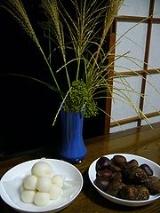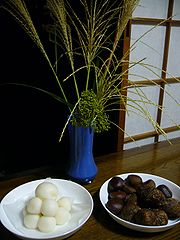
Tsukimi
Encyclopedia

Full moon
Full moon lunar phase that occurs when the Moon is on the opposite side of the Earth from the Sun. More precisely, a full moon occurs when the geocentric apparent longitudes of the Sun and Moon differ by 180 degrees; the Moon is then in opposition with the Sun.Lunar eclipses can only occur at...
typically takes place on the 15th day of the eighth month of the traditional Japanese lunisolar calendar
Lunisolar calendar
A lunisolar calendar is a calendar in many cultures whose date indicates both the moon phase and the time of the solar year. If the solar year is defined as a tropical year then a lunisolar calendar will give an indication of the season; if it is taken as a sidereal year then the calendar will...
; the waxing moon
Lunar phase
A lunar phase or phase of the moon is the appearance of the illuminated portion of the Moon as seen by an observer, usually on Earth. The lunar phases change cyclically as the Moon orbits the Earth, according to the changing relative positions of the Earth, Moon, and Sun...
is celebrated on the 13th day of the ninth month. These days normally fall in September and October of the modern solar calendar
Solar calendar
A solar calendar is a calendar whose dates indicate the position of the earth on its revolution around the sun .-Tropical solar calendars:...
.
The tradition dates to the Heian era, and is now so popular in Japan that some people repeat the activities for several evenings following the appearance of the full moon during the eighth lunisolar month.
Tsukimi traditions include displaying decorations made from Japanese pampas grass
Miscanthus sinensis
Miscanthus sinensis Miscanthus sinensis Miscanthus sinensis (Chinese silver grass, Eulalia grass, maiden grass, zebra grass, Susuki grass, porcupine grass; syn. Eulalia japonica Trin., Miscanthus sinensis f. glaber Honda, Miscanthus sinensis var. gracillimus Hitchc., Miscanthus sinensis var....
(susuki) and eating rice dumplings called Tsukimi dango
Dango
is a Japanese dumpling made from mochiko , related to mochi. It is often served with green tea.Dango are eaten year-round, but the different varieties are traditionally eaten in given seasons...
in order to celebrate the beauty of the moon. Seasonal produce are also displayed as offerings to the moon. Sweet potatoes are offered to the full moon, while beans or chestnuts are offered to the waxing moon the following month. The alternate names of the celebrations, Imomeigetsu (literally "potato harvest moon") and Mamemeigetsu ("bean harvest moon") or Kurimeigetsu ("chestnut harvest moon") are derived from these offerings.
History
Tsukimi refers to the Japanese tradition of holding parties to view the harvest moonHarvest moon
The Full Harvest Moon is the full moon that occurs closest to the autumnal equinox.-Appearance:All full moons rise around the time of sunset. In general the moon rises about 3 minutes later each day...
. The custom is thought to have originated with Japanese aristocrats during the Heian period
Heian period
The is the last division of classical Japanese history, running from 794 to 1185. The period is named after the capital city of Heian-kyō, or modern Kyōto. It is the period in Japanese history when Buddhism, Taoism and other Chinese influences were at their height...
, who would gather to recite poetry under the full moon of the eighth month of the lunisolar calendar
Lunisolar calendar
A lunisolar calendar is a calendar in many cultures whose date indicates both the moon phase and the time of the solar year. If the solar year is defined as a tropical year then a lunisolar calendar will give an indication of the season; if it is taken as a sidereal year then the calendar will...
, known as the "Mid-Autumn Moon." Since ancient times, Japanese people have described the eighth lunisolar month (corresponding to September on the contemporary Gregorian calendar
Gregorian calendar
The Gregorian calendar, also known as the Western calendar, or Christian calendar, is the internationally accepted civil calendar. It was introduced by Pope Gregory XIII, after whom the calendar was named, by a decree signed on 24 February 1582, a papal bull known by its opening words Inter...
) as the best time for looking at the moon, since the relative positions of the earth, sun, and moon cause the moon to appear especially bright. On the evening of the full moon, it is traditional to gather in a place where the moon can be seen clearly, decorate the scene with Japanese pampas grass, and to serve white rice dumplings (known as Tsukimi dango), taro
Taro
Taro is a common name for the corms and tubers of several plants in the family Araceae . Of these, Colocasia esculenta is the most widely cultivated, and is the subject of this article. More specifically, this article describes the 'dasheen' form of taro; another variety is called eddoe.Taro is...
, edamame
Edamame
or Edamame bean is a preparation of immature soybeans in the pod commonly found in Japan, China, and Hawaii. The pods are boiled in water together with condiments such as salt, and served whole....
, chestnut
Chestnut
Chestnut , some species called chinkapin or chinquapin, is a genus of eight or nine species of deciduous trees and shrubs in the beech family Fagaceae, native to temperate regions of the Northern Hemisphere. The name also refers to the edible nuts they produce.-Species:The chestnut belongs to the...
s and other seasonal foods, plus sake as offerings to the moon in order to pray for an abundant harvest. These dishes are known collectively as . Due to the ubiquity of sweet potato or taro among these dishes, the tradition is known as or "Potato harvest moon" in some parts of Japan.
From 862 until 1683, the Japanese calendar was arranged so that the full moon fell on the 13th day of each month. In 1684, however, the calendar was altered so that the new moon
New moon
In astronomical terminology, the new moon is the lunar phase that occurs when the Moon, in its monthly orbital motion around Earth, lies between Earth and the Sun, and is therefore in conjunction with the Sun as seen from Earth...
fell on the first day of each month, moving the full moon two days later, to the 15th day of the month. While some people in Edo
Edo
, also romanized as Yedo or Yeddo, is the former name of the Japanese capital Tokyo, and was the seat of power for the Tokugawa shogunate which ruled Japan from 1603 to 1868...
(present-day Tokyo
Tokyo
, ; officially , is one of the 47 prefectures of Japan. Tokyo is the capital of Japan, the center of the Greater Tokyo Area, and the largest metropolitan area of Japan. It is the seat of the Japanese government and the Imperial Palace, and the home of the Japanese Imperial Family...
) shifted their Tsukimi activities to the 15th day of the month, others continued to observe the festival on the 13th day. Furthermore, there were various regional observances in some parts of Japan on the 17th day of the month, as well as Buddhist observances on the 23rd or the 26th day, all of which were used as pretexts for often late-night parties during the autumn throughout the Edo period
Edo period
The , or , is a division of Japanese history which was ruled by the shoguns of the Tokugawa family, running from 1603 to 1868. The political entity of this period was the Tokugawa shogunate....
. This custom was brought to a swift end during the Meiji period
Meiji period
The , also known as the Meiji era, is a Japanese era which extended from September 1868 through July 1912. This period represents the first half of the Empire of Japan.- Meiji Restoration and the emperor :...
.
Festivals dedicated to the moon have a long history in Japan. During the Heian period
Heian period
The is the last division of classical Japanese history, running from 794 to 1185. The period is named after the capital city of Heian-kyō, or modern Kyōto. It is the period in Japanese history when Buddhism, Taoism and other Chinese influences were at their height...
elements of the Chinese
China
Chinese civilization may refer to:* China for more general discussion of the country.* Chinese culture* Greater China, the transnational community of ethnic Chinese.* History of China* Sinosphere, the area historically affected by Chinese culture...
Mid-Autumn Festival
Mid-Autumn Festival
The Mid-Autumn Festival , also known as the Moon Festival or Mooncake Festival or Zhongqiu Festival, is a popular lunar harvest festival celebrated by Chinese and Vietnamese people. A description of the festival first appeared in Rites of Zhou, a written collection of rituals of the Western Zhou...
were introduced to Japan. Members of the aristocratic class would hold moon-viewing events aboard boats in order to view the moon's reflection on the surface of the water. The writing of tanka
Tanka
Tanka may refer to:* Tanka, a form of Japanese waka * Tanka prose, a literary genre which combines tanka poems and prose* Thangka, a pictorial representation in Tibetan Buddhism...
poetry was also an element of such mid-autumn moon viewing festivities.
There are specific terms in Japanese to refer to occasions when the moon is not visible on the traditional mid-autumn evening, including Mugetsu (無月 literally: no-moon) and Ugetsu (雨月 rain-moon). Even when the moon is not visible, however, Tsukimi parties are held.
Tsukimi related foods
It is traditional to serve Tsukimi dangoDango
is a Japanese dumpling made from mochiko , related to mochi. It is often served with green tea.Dango are eaten year-round, but the different varieties are traditionally eaten in given seasons...
and seasonal produce offerings during Tsukimi, as described above. In addition, there are several other dishes associated with Tsukimi.
Boiled soba
Soba
is the Japanese name for buckwheat. It is synonymous with a type of thin noodle made from buckwheat flour, and in Japan can refer to any thin noodle . Soba noodles are served either chilled with a dipping sauce, or in hot broth as a noodle soup...
or udon
Udon
is a type of thick wheat-flour noodle of Japanese cuisine.Udon is usually served hot as noodle soup in its simplest form as kake udon, in a mildly flavoured broth called kakejiru which is made of dashi, soy sauce , and mirin. It is usually topped with thinly chopped scallions...
noodles topped with nori
Nori
is the Japanese name for various edible seaweed species of the red alga Porphyra including most notably P. yezoensis and P. tenera, sometimes called laver. Finished products are made by a shredding and rack-drying process that resembles papermaking...
and raw egg, then covered with broth are known as Tsukimi soba or Tsukimi udon. In Kitakyushu an egg served atop yaki udon
Yaki udon
are thick, smooth, white Japanese noodles eaten with a special sauce, meat and vegetables. It is simple to make and a popular dish in Japan. It originated in Kokura, Fukuoka Prefecture after the Pacific War.-External links:*...
is known as Tenmado, another name for Tsukimi in the local dialect.
At some fast food restaurants in Japan a special Fall Menu is offered during September and October featuring fried egg
Fried egg
A fried egg is a food made from an egg fried whole with minimal accompaniment. They are traditionally eaten for breakfast in western countries, but may be eaten at other times of the day.-China:...
sandwiches known as Tsukimi burgers.

